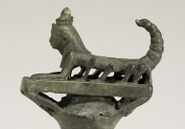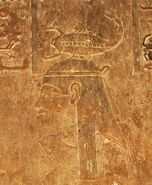Serket
Topic: Religion
 From HandWiki - Reading time: 4 min
From HandWiki - Reading time: 4 min
| Serket | |
|---|---|
 The Egyptian goddess Serquet is often depicted as a woman with a scorpion gracing her crown. She holds the ankh, the symbol of life, in one hand and a was-sceptre, representing power, in the other. | |
| Name in hieroglyphs | <hiero>z:r-N29:t-B1</hiero>[1] |
| Symbol | Scorpion |
| Personal information | |
| Parents | Set, or Khnum and Neith |
| Siblings | Apep, Sobek |
| Consort | Horus the Younger or Horus the Elder |
| Offspring | Qebehsenuef and Nehebkau |
Serket /ˈsɜːrˌkɛt/ (also known as Serqet, Selket, Selqet, or Selcis) is the goddess of fertility, nature, animals, medicine, magic, and healing venomous stings and bites in Egyptian mythology, originally the deification of the scorpion.[2] Her family life is unknown, but she is sometimes credited as the daughter of Neith and Khnum, making her a sister to Sobek and Apep.
Scorpion stings lead to paralysis and Serket's name describes this, as it means "(she who) tightens the throat"; however, Serket's name also can be read as meaning "(she who) causes the throat to breathe", and so, as well as being seen as stinging the unrighteous, Serket was seen as one who could cure scorpion stings and the effects of other venoms such as snakebites.
In the art of ancient Egypt, Serket was shown as a scorpion (a symbol found on the earliest artifacts of the culture, such as from Naqada III) or as a woman with a scorpion on her head. Although Serket does not appear to have had any temples, she had a sizable number of priests in many communities.
One of the most dangerous species of scorpion, the Deathstalker (Leiurus quinquestriatus) resides in North Africa, and its sting may kill, so Serket was considered a highly important goddess, and sometimes she was considered by pharaohs to be their patron. Her close association with the early rulers implies that she was their protector, notably Scorpion I and Scorpion II.
As the protector against venom and snakebite, Serket often was said to protect the deities from Apep, the great snake-demon of evil, sometimes being depicted as the guard when Apep was captured.
As many of the venomous creatures of Egypt could prove fatal, Serket also was considered a protector of the dead, particularly being associated with venoms and fluids causing stiffening. She was thus said to be the protector of the tents of embalmers, and of the canopic jar associated with venom—the jar of the intestine—which was deified later as Qebehsenuef, one of the four sons of Horus, who were her sons by Horus.
As the guard of one of the canopic jars and a protector, Serket gained a strong association with Neith, Isis, and Nephthys, who also performed similar functions. Eventually, Serket began to be identified with Isis, sharing imagery and parentage, until finally, Serket was said to be merely an aspect of Isis, whose cult had become dominant.
It has been suggested that Serket's identification with a scorpion may be a misinterpretation of the determinative of her name and animal associated with her, and that could refer not to a scorpion, but rather to a water scorpion (Nepidae). According to this hypothesis, Serket is referred to as "she who gives breath" because of the way water scorpions seem to breathe underwater. The appearance of a waterscorpion must have made it be associated with the scorpion, therefore the use of the goddess for curing scorpion stings and other venomous creatures, or maybe exactly because she "causes to breathe", not for the physical similarities of the creatures.[3]
In popular culture
- In the webcomic Homestuck of MS Paint Adventures, Vriska Serket is a troll who brings about life in a new universe, causes many deaths, and is associated with scorpions.
- Serqet is one of the playable characters in Hi-rez MOBA, SMITE and acts out as a melee assassin.
- In Call of Duty: Black Ops IV, Serket is alluded to in the Chaos branch of the storyline, which is heavily mythology driven. Serket is mentioned in the map IX, which takes place in a Roman coliseum, where she presents the character with a scorpion that can be used to extract the sap of a tree in Danu's temple to then poison the mystery box of weapons and guarantee the receipt of the map's wonder weapon. The wonder weapon takes the form of a chained scorpion that shoots a bolt of light to trap and suspend zombies. It is known as the Death of Orion initially, but can be upgraded to the more powerful Serket's Kiss.[4]
- In the video game PowerSlave, Serket (named Selkis) appears as a boss character, portrayed as a monstrous half humanoid half scorpion-like creature.
- Serqet, a character based off of the Egyptian goddess, appears in Rick Riordan's The Red Pyramid and The Serpent's Shadow. She appears to have the ability to control scorpions and is often seen riding on a giant black scorpion.
- The goddess Serket appears as a minor character in the 2003 animated series Tutenstein. She appears wearing a purple scorpion on her head which is stinging her. This causes her to complain about headaches.
References
- ↑ Zauzich, Karl-Theodor (1992). Hieroglyphs Without Mystery. Austin: University of Texas Press. pp. 69.
- ↑ Pharaonic Gods Egyptian Museum
- ↑ Spieser, Cathie (2001). "Nouvelles approches de l'image emblématique de Serket: le serpent, la corne et l'uterus". Revue d'Égyptologie 52: 251–264. doi:10.2143/RE.52.0.504258. ISSN 0035-1849.
- ↑ "Achievements and Trophies - Call of Duty: Black Ops 4 Wiki Guide - IGN". https://www.ign.com/wikis/call-of-duty-black-ops-4/Achievements_and_Trophies.
Further reading
- von Känel, Frédérique (1984) (in fr). Les prêtres-ouâb de Sekhmet et les conjurateurs de Serket. Presses Universitaires de France.
 KSF
KSF


